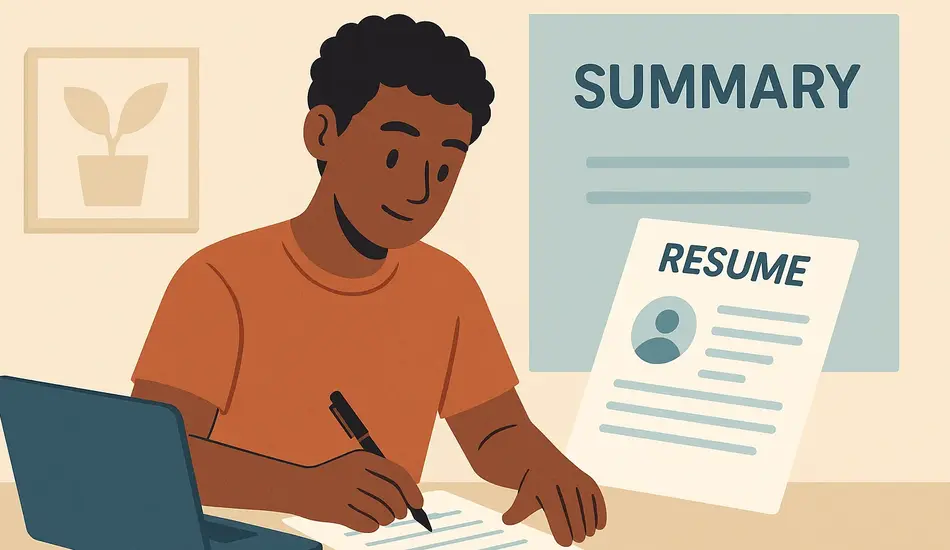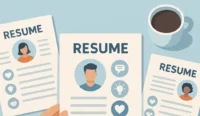Crafting a compelling resume summary is one of the most impactful ways for aspiring interns to capture a hiring manager’s attention—right at the very top of your resume. As an intern, you may not yet have years of professional experience to showcase, but a well-written summary can spotlight your potential, key skills, and the unique value you bring. In this comprehensive guide, you’ll learn how to structure, tailor, and refine your resume summary so you stand out among other candidates.
Table of Contents
1. What Is a Resume Summary (and Why It Matters for Interns)?
A resume summary is a concise blurb—typically 2–4 sentences—positioned at the very top of your resume. It succinctly encapsulates who you are, the key skills you possess, notable achievements or experiences, and what you’re seeking next.
- For interns with limited work history, it serves as a quick elevator pitch, highlighting transferable skills, academic projects, club leadership, volunteer work, and technical proficiencies.
- Recruiters often spend mere seconds scanning each resume. A summary gives them an immediate snapshot of your fit for the role, increasing the chance they’ll read further.
By investing time into crafting a targeted summary, you set yourself up to capture attention—despite being at an early career stage.
2. Resume Summary vs. Objective: Understanding the Difference
Internship seekers sometimes confuse summary statements with objective statements. Here’s how they differ:
| Aspect | Summary Statement | Objective Statement |
| Focus | What you bring: skills, achievements, value | What you want: role, career goals |
| Tone | Candidate-centric (“Data-driven analyst…”) | Employer-centric (“Seeking position at…”) |
| Recruiter Appeal | Demonstrates immediate relevance and impact | Often seen as generic or self-serving |
Key takeaway: Opt for a summary statement that emphasizes your strengths and contributions rather than your aspirations alone.
3. The Three Core Elements of an Intern’s Resume Summary
When writing your resume summary, address these three pillars:
- Your Identity & Background
- Who you are academically (e.g., “third-year Biology major”)
- Any specialized focus or minor (e.g., “with a concentration in Bioinformatics”)
- Who you are academically (e.g., “third-year Biology major”)
- Your Top Skills & Achievements
- 2–3 hard or soft skills most relevant to the role
- One quantifiable accomplishment (e.g., “analyzed data from 150+ samples”)
- 2–3 hard or soft skills most relevant to the role
- Your Value Proposition & Goal
- What you aim to contribute immediately (“to support laboratory research…”)
- How the internship aligns with your learning objectives (“while honing PCR and genomic analysis techniques”)
- What you aim to contribute immediately (“to support laboratory research…”)
4. Step-by-Step Guide to Writing Your Summary
4.1. Identify Your Intern’s “Brand”
- Reflect on Strengths: List your top skills—technical tools, methodologies, soft skills.
- Consider Academic Highlights: Capstone projects, relevant coursework, research assistantships.
- Define Your Focus: What area excites you most (e.g., front-end development, consumer insights, beta testing)?
4.2. Select Top 2–3 Skills or Strengths
- Choose skills directly referenced in the internship description.
- Balance hard skills (e.g., Python, CAD, SPSS) with soft skills (e.g., collaboration, communication).
4.3. Showcase Achievements or Projects
- Pick one standout accomplishment—academic, extracurricular, or volunteer.
- Use numbers where possible: team size, budget, survey responses, page views, etc.
4.4. Align with the Role’s Needs
- Mirror Keywords: If the posting asks for “data visualization,” use that exact phrase.
- Company Context: Tailor to industry—startups may value adaptability; large firms, process orientation.
4.5. Write, Edit, and Refine
- Draft a 3–4 sentence summary following the structure above.
- Eliminate Jargon: Avoid buzzwords that add no real meaning.
- Trim Excess: Stay under 75 words—concise and powerful.
- Proofread: Check grammar, consistency, and ensure the tone matches the company culture.
5. Tailoring Your Summary for Different Internship Fields
5.1. Engineering & Technical Internships
- Highlight: Technical proficiencies, problem-solving, lab or project experience.
- Example Skill Phrases: “Finite element analysis,” “circuit design,” “field testing,” “Git workflows.”
5.2. Marketing & Communications Internships
- Highlight: Creativity, analytics, campaign management, writing prowess.
- Example Skill Phrases: “Google Analytics,” “A/B testing,” “content calendars,” “social-media engagement.”
5.3. Business, Finance & Consulting Internships
- Highlight: Financial modeling, market research, strategic analysis, teamwork.
- Example Skill Phrases: “Excel & VBA,” “competitive benchmarking,” “presentation development.”
5.4. Creative & Design Internships
- Highlight: Design tools, visual storytelling, user-experience sensibility.
- Example Skill Phrases: “Adobe Creative Suite,” “Figma prototypes,” “brand guidelines.”
6. Common Mistakes to Avoid
- Vague Buzzwords: Steer clear of “hardworking,” “team player,” “detail-oriented” without context.
- Overloading Technical Jargon: Too many acronyms can confuse non-technical HR screeners.
- Objective Statements: Don’t lead with “Seeking an internship…”—focus on your value instead.
- Lengthy Paragraphs: Keep it to 2–4 sentences; lengthy prose will get skimmed over.
7. Real-World Examples of Strong Intern Summary Statements
Software Development Intern
“Computer Science junior proficient in Java, Python, and SQL through coursework and personal projects. Developed a RESTful API to automate event registrations, reducing manual workload by 40%. Seeking to leverage strong coding skills and collaborative mindset at NextGen Softworks.”
Marketing Intern
“Junior Marketing major skilled in Adobe Creative Suite and Google Analytics; increased student-club social engagement by 60% via targeted Instagram campaigns. Eager to apply creativity and data-driven insight to support marketing initiatives at BrightWave Digital.”
Mechanical Engineering Intern
“Third-year Mechanical Engineering student experienced in SolidWorks and rapid prototyping, with hands-on experience designing drone components in a team of four. Aiming to contribute strong CAD skills and problem-solving abilities to AeroTech Innovations’ R&D projects.”
8. Maximizing Impact: Additional Tips
- Use Active Language: Start sentences with strong verbs—“led,” “analyzed,” “designed.”
- Tailor Each Application: Don’t reuse the exact summary; tweak for every role.
- Leverage LinkedIn: Use your summary on LinkedIn to reinforce your brand.
- Solicit Feedback: Ask mentors or career advisors to review for clarity and impact.
- Monitor Results: If you’re not landing interviews after several applications, revisit and refine your summary.
9. Frequently Asked Questions (FAQs)
Q1. Should I include GPA in my resume summary?
– Only if it’s exceptionally high (e.g., 3.8+) and the role emphasizes academic performance. Otherwise, reserve GPA for the education section.
Q2. Can I write a summary if I have zero professional experience?
– Absolutely. Focus on academic projects, leadership roles, volunteer work, and transferable skills.
Q3. How long should my summary be?
– Aim for 50–75 words (2–4 sentences). Conciseness demonstrates clarity of thought.
Q4. Where should the summary appear on my resume?
– Directly under your name and contact information, before education and experience sections.
Q5. Is it okay to use first-person pronouns (I, me)?
– Generally, omit pronouns; write in telegraphic style (e.g., “Detail-oriented researcher…”).
10. Conclusion
A strategic, tailored resume summary sets the tone for the rest of your application and helps hiring teams immediately recognize your potential—even as an intern. By clearly stating your academic background, spotlighting your top skills and achievements, and aligning with the specific internship’s needs, you’ll craft a summary that not only gets read but also compels employers to learn more about you. Invest in refining this brief section—it just might be the difference between landing the interview and blending into the crowd.






